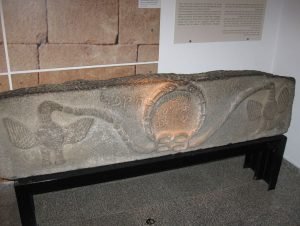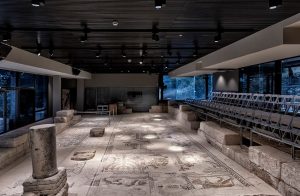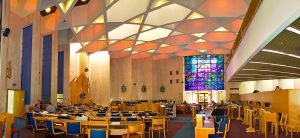The rabbinical equivalent of “you snooze, you lose” appears on daf 51 of Bava Batra:
“Rav Naḥman said to Rav Huna: The Master was not with us in the evening within the boundaries (תחומא) of the town, where we said a superior matter.”
The interesting word here is תחומא /techuma, a word that means boundary. In two similar stories, one in Bava Kamma 20a and one in Zevachim 2b, Rashi explains that it means that you were not nearby and could not join us. He adds that some say near us in the bet midrash but he likes that explanation less. Rashi’s understanding is related to the idea of techum Shabbat, the distance one is allowed to walk on Shabbat without making an eruv.
The Rashbam on our Gemara however expands on the explanation that Rashi rejects:
“their study halls (batei midrash) would be on the edge of the Shabbat boundary so that people from surrounding towns could come and join them on Shabbat”
Rashbam’s idea seems similar to a situation mentioned in Eruvin:
“If a Sage comes from the east [and he is spending Shabbat beyond the boundaries of my town], my eiruv is in the east, [so that I may go out to greet him there]; and if he comes from the west, my eiruv is in the west.” (Eruvin 36b)
The idea of going out of town or to the neighboring town to learn with a rabbi seems to have been well known, lending support to Rashbam’s explanation that the techuma is a bet midrash. The Arukh dictionary gives one of the meanings of techum as תחומה של תורה, the domain of Torah.
The definition of techuma as bet midrash leads us to the question of what was a bet midrash and where was it located. One caveat before we begin – all three stories that mention techuma take place with Babylonian rabbis. Were the batei midrash in Babylonia indeed outside the town? Perhaps, but since we have little to no archaeology of the Jewish towns of Babylonia, we cannot (yet) answer that question. Instead, let’s look at Eretz Yisrael and her study halls.
The term bet midrash, study hall, is mentioned often in the Gemara. Just to give a few examples: when Rabban Gamliel is kicked out of the Sanhedrin (temporarily), he still returns to the bet midrash and does not separate himself from his colleagues (Berachot 28a). In that same story, it is told that he refused to allow any student into the bet midrash who was not pure of heart (תוכו כברו). Another story tells of an encounter between Rabbi Yehoshua and Rabbi Yochanan ben Beroka and Rabbi Elazar ben Hizma. Rabbi Yehoshua asks what new idea was taught in the bet midrash today because of course:
“there cannot be a study hall without a novelty. “(Hagigah 3a)
The term bet midrash comes from the verb darash, to teach or to explicate (the Arabic word madrasa has the same meaning as a bet midrash). The bet midrash was distinguished from the bet knesset, the synagogue:
“And Rav Pappi said in the name of Rava: To convert a building from a synagogue into a study hall is permitted, but from a study hall into a synagogue is prohibited,” (Megillah 26b)
“Rabbi Levi bar Ḥiyya said: One who leaves the synagogue and enters the study hall and engages in Torah study, is privileged to receive the Divine Presence, as it is stated: ‘They go from strength to strength, every one of them appears before God in Zion’ ” (Psalms 84:8) (Berachot 64a)
It seems clear from these sources that the bet midrash was a distinct structure, separate from the synagogue, and perhaps even preferable to it as this testimony about Rabbi Ami and Rabbi Asi indicates:
“Rabbi Ami and Rabbi Asi, despite the fact that they had thirteen synagogues in Tiberias, they would only pray between the pillars where they studied.” (Berachot 8a)
While the bet midrash may have had more holiness (and so cannot be sold to build a bet knesset), it had certain dispensations that a synagogue did not, since people would spend many hours there. It is forbidden to sleep or eat in a synagogue, but permitted in a bet midrash. (Shulchan Aruch Orach Hayyim 151:3) Special prayers were said upon entering and leaving the bet midrash (Berachot 28b).
In the last century or so of archaeological excavations in Israel, dozens of ancient synagogues have been found. No batei midrash have been found, except for one and even that one is only a sign, not a structure in itself. In the Golan, in the village of Daburah, a sign that reads “this is the bet midrash of Rabbi Elazar haKappar” was found.

Ori~, Attribution, via Wikimedia Commons
Why haven’t we found batei midrash? The simplest answer is that unlike a synagogue, which has certain distinguishing characteristics: an ark, benches, decorations like a menorah and dedication signs; we don’t know what a bet midrash should look like. Is it large or small, what features does it have, is it just a simple building where people could gather? Without an archetype we don’t know what we are looking for.

Reconstructed synagogue in Zippori
Shai knaani, CC BY-SA 4.0 <https://creativecommons.org/licenses/by-sa/4.0>, via Wikimedia Commons
Dr. Gil Huttenmeister suggests that the bet midrash was in the same building as the bet knesset, perhaps in a side room. After all, in a small town, it is unlikely that two grand buildings would be built. One synagogue would have to suffice for many purposes. Perhaps in a large city, there was a designated bet midrash. Dr. Aharon Oppenheimer disagrees and says it is clear from the sources, such as being allowed to sell a bet knesset to build a bet midrash, that these are two separate structures. We just have not found them yet. There are suggestions that certain large buildings, like a basilica in the main area of ancient Tiberias, could have been batei midrash.

The excavations in ancient Tiberias
Bukvoed, CC BY 3.0 <https://creativecommons.org/licenses/by/3.0>, via Wikimedia Commons
Did the rabbis have a large and beautiful bet midrash for Torah study? Or was the term a figurative one and they actually gathered to learn in the shade of some trees? Today, especially in Israel, we are privileged that men and women can learn in impressive and inspiring surroundings, but the Torah they learn is the same, whether in a humble or a grand abode.

Bet midrash at Bar Ilan University
Bar-Ilan University, CC BY-SA 2.0 <https://creativecommons.org/licenses/by-sa/2.0>, via Wikimedia Commons
Postscript: I just came across an old article called Learning and Teaching in the Open Air in Palestine by Rabbi A. Buchler where he brings many proofs that the rabbis taught and judged outside, under trees. One of his examples is the famous story of the oven of Achnai (Bava Metzia 59b) where Rabbi Eliezer calls on the carob tree and the aqueduct to prove he is correct, showing that the rabbis were outside.










